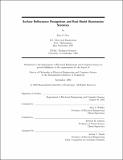| dc.contributor.advisor | Alan S. Willsky and Edward H. Adelson. | en_US |
| dc.contributor.author | Dror, Ron O. (Ron Ofer), 1975- | en_US |
| dc.contributor.other | Massachusetts Institute of Technology. Dept. of Electrical Engineering and Computer Science. | en_US |
| dc.date.accessioned | 2005-05-19T15:15:35Z | |
| dc.date.available | 2005-05-19T15:15:35Z | |
| dc.date.copyright | 2002 | en_US |
| dc.date.issued | 2003 | en_US |
| dc.identifier.uri | http://hdl.handle.net/1721.1/16911 | |
| dc.description | Thesis (Ph. D.)--Massachusetts Institute of Technology, Dept. of Electrical Engineering and Computer Science, February 2003. | en_US |
| dc.description | Includes bibliographical references (p. 141-150). | en_US |
| dc.description | This electronic version was submitted by the student author. The certified thesis is available in the Institute Archives and Special Collections. | en_US |
| dc.description.abstract | Humans distinguish materials such as metal, plastic, and paper effortlessly at a glance. Traditional computer vision systems cannot solve this problem at all. Recognizing surface reflectance properties from a single photograph is difficult because the observed image depends heavily on the amount of light incident from every direction. A mirrored sphere, for example, produces a different image in every environment. To make matters worse, two surfaces with different reflectance properties could produce identical images. The mirrored sphere simply reflects its surroundings, so in the right artificial setting, it could mimic the appearance of a matte ping-pong ball. Yet, humans possess an intuitive sense of what materials typically "look like" in the real world. This thesis develops computational algorithms with a similar ability to recognize reflectance properties from photographs under unknown, real-world illumination conditions. Real-world illumination is complex, with light typically incident on a surface from every direction. We find, however, that real-world illumination patterns are not arbitrary. They exhibit highly predictable spatial structure, which we describe largely in the wavelet domain. Although they differ in several respects from the typical photographs, illumination patterns share much of the regularity described in the natural image statistics literature. These properties of real-world illumination lead to predictable image statistics for a surface with given reflectance properties. We construct a system that classifies a surface according to its reflectance from a single photograph under unknown illumination. Our algorithm learns relationships between surface reflectance and certain statistics computed from the observed image. | en_US |
| dc.description.abstract | (cont.) Like the human visual system, we solve the otherwise underconstrained inverse problem of reflectance estimation by taking advantage of the statistical regularity of illumination. For surfaces with homogeneous reflectance properties and known geometry, our system rivals human performance. | en_US |
| dc.description.statementofresponsibility | by Ron O. Dror. | en_US |
| dc.format.extent | 150 p. | en_US |
| dc.format.extent | 3001789 bytes | |
| dc.format.extent | 3001547 bytes | |
| dc.format.mimetype | application/pdf | |
| dc.format.mimetype | application/pdf | |
| dc.language.iso | eng | en_US |
| dc.publisher | Massachusetts Institute of Technology | en_US |
| dc.rights | M.I.T. theses are protected by copyright. They may be viewed from this source for any purpose, but reproduction or distribution in any format is prohibited without written permission. See provided URL for inquiries about permission. | en_US |
| dc.rights.uri | http://dspace.mit.edu/handle/1721.1/7582 | |
| dc.subject | Electrical Engineering and Computer Science. | en_US |
| dc.title | Surface reflectance recognition and real-world illumination statistics | en_US |
| dc.type | Thesis | en_US |
| dc.description.degree | Ph.D. | en_US |
| dc.contributor.department | Massachusetts Institute of Technology. Department of Electrical Engineering and Computer Science | |
| dc.identifier.oclc | 52642832 | en_US |
